1 + 100[1] 1011 August 2024
R is a programming language used by many researchers to analyse data. The aims of these notes are:
These notes focus on the the use of R to manage and plot data. They not teach any statistics, though they include examples showing how to do t-tests and chi-square tests.
These notes use data on countries around the world based on free material from GAPMINDER.ORG, CC-BY LICENSE. Hans Rosling, the co-founder of Gapminder, has given some extremely impressive presentations using Gapminder data, for example here and here.
Some parts of these notes are taken directly from a longer course called R for Reproducible Scientific Analysis, and I have made some modifications. The course R for Reproducible Scientific Analysis is Copyright (c) The Carpentries. Here is the license governing the use of the course.
Half-way through writing these notes, I discovered an excellent online book, R for Non-Programmers: A Guide for Social Scientists by Daniel Dauber (2024). If I had found this book sooner, I would have included many more good ideas from it.
To work through the exercises in these notes, you need two pieces of software installed on your computer:
Please make sure you have the latest versions installed. If you have any problems installing them, take a look at the instructions in Chapter 3 of R for Non-Programmers.
There is probably too much here to work through in 3 hours. If you are not very familiar with R, I’d recommend working though the following sections in order:
readr packagedplyr package to look at the asean_dataAfter that, if you have time, you can continue with
ggplot2 packageor you can jump to
If you have your own data in a CSV file, try loading it as in Section 3.1.
Please take your time: try making some changes to the R commands here, and see what happens.
Research is a multi-step process: once you’ve designed an experiment and collected data, the real fun begins with analysis! In this section, we look at some of the fundamentals of the R language as well as some best practices for organizing code for research projects that will make your life easier.
Although we could use a spreadsheet in Microsoft Excel or Google sheets to analyze our data, these tools are limited in their flexibility and accessibility. Critically, they also are difficult to share steps which explore and change the raw data, which is key to “reproducible” research.
Therefore, these notes will help you begin exploring your data using R and RStudio. The R program is available for Windows, Mac, and Linux operating systems, and is a freely-available where you downloaded it above. To run R, all you need is the R program.
However, to make using R easier, we will use the program RStudio, which we also downloaded above. RStudio is a free, open-source, Integrated Development Environment (IDE). It provides a built-in editor, works on all platforms (including on servers) and provides many advantages such as integration with version control and project management.
R was originally developed by statisticians, and many people use it for statistics: things like regression, hypothesis testing and calculating confidence intervals. There are various pieces of commercial statistical software that do these things, such as SPSS, Stata and SAS. Unlike these, R is free, open-source software. Thousands of people contribute to R by writing packages (Section 2.12), and these packages do a wide range of useful things. In particular, they make it easier to organise, manage and tidy data, and to plot data. In some jobs I have used R to do these things without doing any statistics, and I think it does them better than other statistical software. Even if you are planning to do lots of statistical analyses, data is often messy, and it takes more time to organise and clean data than to analyse it. So don’t underestimate the value of a system like R that is good for this!
Lots of people say that R takes time to learn: it will take you longer to work out how to do a t-test in R than in SPSS. In this Nature article from 2014, ecologist Megan Jennings says it is worth spending the time learning R:
“Make that time. Set it aside as an investment: for saving time later, and for building skills that can be used across multiple problems we face as scientists.”
R is not designed for doing algebra and solving equations, or for plotting graphs. Other tools are better for these things, such as the commercial software Matlab and Mathematica and the free website Desmos.
We will begin with raw data, perform exploratory analyses, and learn how to plot results graphically. This example starts with data from gapminder.org, containing yearly statistics for many countries through time. Can you read the data into R? Can you calculate the total population of ASEAN countries? Can you plot life expectancy for various countries? By the end of these lessons you will be able to do things like these in under a minute!
Basic layout
When you first open RStudio, you will see three panels:
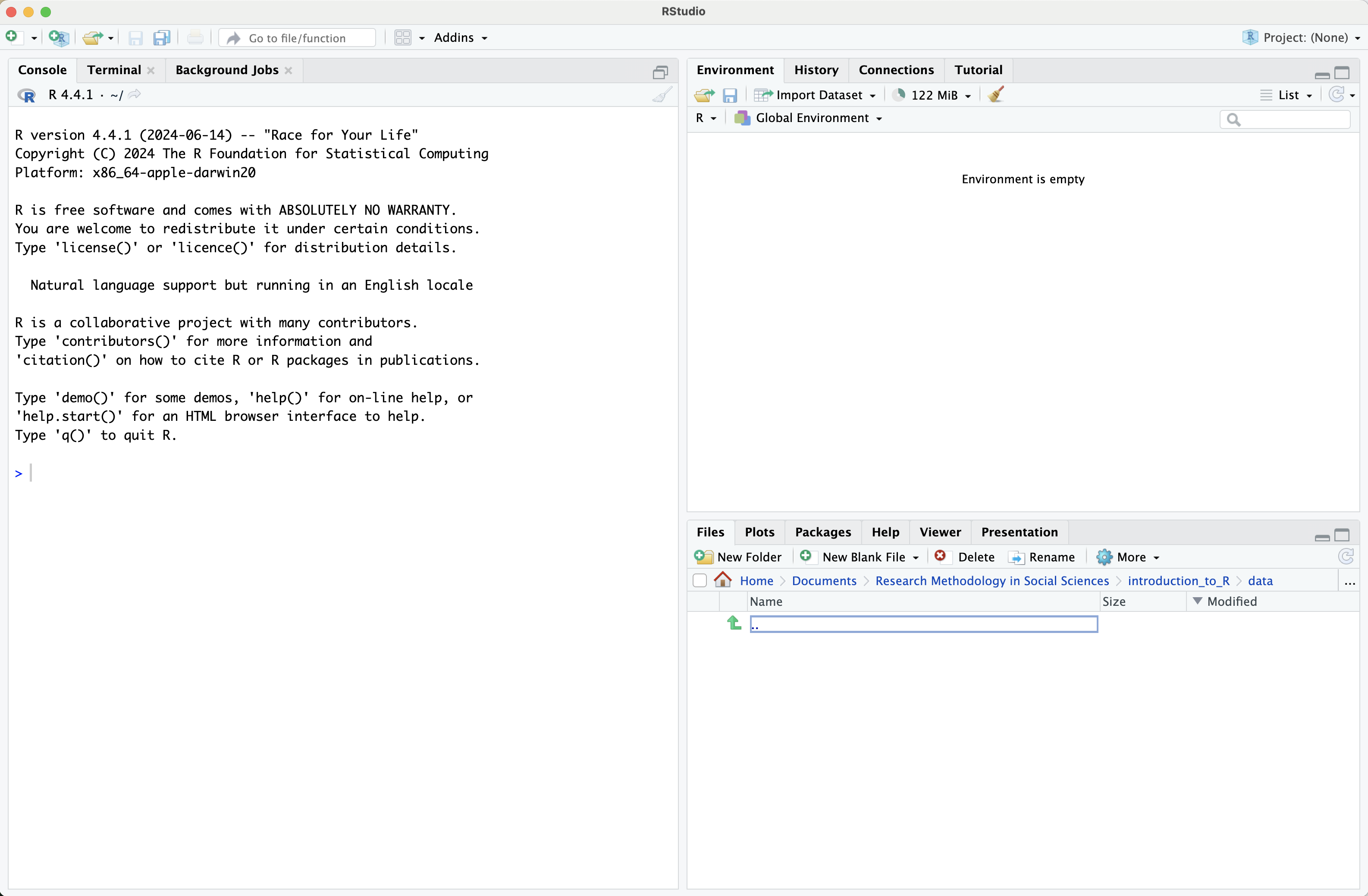
Once you open files, such as R scripts, an editor panel will also open in the top left. You can start a new R script by going to the “File” menu, and choosing “New File”, then “R script” (both of these choices are at the top).

Any commands that you write in the R console can be saved to a file to be re-run again. Files containing R code to be ran in this way are called R scripts. R scripts have .R at the ends of their names to let you know what they are.
There are two main ways you can work in RStudio:
Test and play within the interactive R console then copy code into a .R file to run later.
Start writing in a .R file and use RStudio’s short cut keys for the Run command to push the current line, selected lines or modified lines to the interactive R console.
source function.RStudio offers you several ways to run code from within the editor window. To run the current line, you can
1. click on the Run button above the editor panel, or
2. select “Run Lines” from the “Code” menu, or
3. hit Ctrl+Return in Windows or Linux or ⌘+Return on OS X. To run several lines of code (instead of just one), select the lines first and then use one of these 3 methods.
Much of your time in R will be spent in the R interactive console. This is where you will run all of your code, and can be a useful environment to try out ideas before adding them to an R script file.
The first thing you will see in the R interactive session is a bunch of information, followed by a “>” and a blinking cursor. Here you type in commands, R tries to execute them, and then returns a result.
This is the simplest thing you can do with R.
If you type
1 + 100
in the console and press return, it shows the answer (101) with [1] in front of it:
[1] 101
We’ll discuss the [1] later.
If you type an incomplete command, like
3 - (instead of 3 - 2 )
and press return, R will show a
+
to indicate that it is expecting something else. If you want to cancel a command you can hit Esc and RStudio will give you back the > prompt.
From now on in these notes, we’ll show R commands and the results they give like this:
with the R commands in a grey box and the results in a pale purple box. You can copy the R commands by hovering on the right edge of the grey box and clicking on the clipboard. Don’t just read the commands… copy and paste them into RStudio, run them for yourself, try changing them, and see what happens!
When using R was a calculator, the order of operations is the same as you learned in school. Things are executed in this order:
(, )^ or ** (can use either symbol)* and divide /+ and subtract -For example, compare the difference between
and
Large and small numbers, for example the population of China in 2022 (1.43 billion), are written in scientific notation:
e+09 is another way of writing for “multiplied by 10 to the power 9” (or *10^9), and 10 to the power 9 is one billion
R can also do other things you can do with a calculator. For example, to calculate the square-root of 36, type
The command sqrt is known as a function. R has many built in functions: some do maths like sqrt, and some do other things. To call a function, type its name, followed by opening and closing brackets. Some functions take arguments as inputs (things typed inside the brackets). For example sqrt takes a single number as an argument (36 in the example above), and calculates its square root.
Some functions don’t take any arguments:
[1] "/Users/jimstankovich/Documents/GitHub/notes"(Here we have added comments to help explain our R commands. Anything on a line after a # is ignored by R, so it is a good place to write comments.)
Other functions take different types of arguments, for example
This example shows that R works with text as well as numbers. The quotation marks " are used to show that the thing inside is text, not something else like a number, a function, or an object (Section 2.8).
Don’t worry about trying to remember every function in R. You can look them up on Google, or if you can remember the start of the function’s name, type it and RStudio will provide some suggestions for the end of the name. For example, if you type sq, RStudio will list various functions starting with “sq”, including sqrt().
Typing a ? before the name of a command will open the help page for the command on the bottom right. The help page includes a detailed description of the command and how it works. The bottom of the help page will usually has examples of how to use the command. (This is often the most useful part of the help page!)
A key concept in R, and in any programming language, is to give names to pieces of data. You can give names to single numbers, a bit like x’s and y’s in algebra you did in high school, or to huge tables of data. Any name (like x or y) with something assigned to it is called an object.
The -> symbol is used to assign some data to an object. For example, the command
creates an object called x, and sets x equal to 9.
To check what value an object has, just type the name of the object:
Once x has been assigned a value, we can use it for calculations:
You can also assign a new value to x
Note that the command x <- 42 changes the value of x, but it doesn’t show us what the new value of x is. The x on the line below asks R to show us the value of x.
You can also change the value of x based on what its previous value was:
To interpret the command x <- x + 1, start on the right. x + 1 means take the current value of x (42) and add 1 to it (43). The arrow pointing to the left says: take the new value you calculated on the right (43) and assign it to the thing on the left (x).
If you prefer, you can use longer names for objects that are more informative than x, such as
These names can only include letters, numbers, _, and ., and names must start with a letter. So the following names are invalid:
22pop (cannot start with numbers)thailand pop (cannot have spaces)pop-22 (cannot have a -)If you use long names, you don’t have to type them in full every time. Once RStudio knows that you have created an object called population_of_thailand_2022, it will suggest the full name after you type the first few characters.
This gives the object mass a value of 47.5.
This gives the object mass a value of 122.
This takes the existing value of mass (47.5) and multiplies it by 2.3 to give it a new value of 109.25.
This will subtract 20 from the existing value of 122 to give age a new value of 102.
Objects can store other types of information, not just numbers. For example, they can store text:
Objects can also store more than one piece of information, not just a single number or a single piece of text. Two of the most important types of objects in R with multiple pieces of information are vectors and data.frames.
A vector is an object containing a list of things, where everything in list has the same basic data type. For example, everything in the vector can be a piece of text, or everything can be a number.
We can create vectors by using the R function c(), which “combines” or “concatenates” pieces of information. For example, here is a command to create a vector with 10 pieces of information: the names of the 10 ASEAN countries
ASEAN_countries <- c("Brunei","Cambodia","Indonesia",
"Lao","Myanmar","Malaysia","Philippines",
"Singapore","Thailand","Vietnam")
ASEAN_countries [1] "Brunei" "Cambodia" "Indonesia" "Lao" "Myanmar"
[6] "Malaysia" "Philippines" "Singapore" "Thailand" "Vietnam" [1] FALSE FALSE FALSE TRUE FALSENote that you can use F and T as abbreviations for FALSE and TRUE.
R has special notation (:) to make lists of consecutive numbers:
Note the [6] in the vector ASEAN_countries. This indicates that "Malaysia" is the 6th element of the vector (and [1] indicates that "Brunei" is the 1st element of the vector). We can use square brackets to refer to individual elements of vectors
or subsets of vectors
countries_sharing_borders_with_Thailand <- ASEAN_countries[c(2,4:6)]
countries_sharing_borders_with_Thailand[1] "Cambodia" "Lao" "Myanmar" "Malaysia"[1] "Cambodia" "Lao" "Myanmar" "Thailand" "Vietnam" Some numerical operations can be applied to vectors of numbers, just as they are applied to individual numbers:
data.frameIf we have 2 or more vectors of the same length, we can join them to make a table of data with multiple columns, one vector in each column, like something you might enter into a spreadsheet. In R, a table of data is called a data.frame. To make a data.frame, lets combine our vector ASEAN_countries with a vector of national dishes:
national_dish <- c("ambuyat", "amok", "gado-gado", "chicken soup", "lahpet", "nasi lemak", "adobo", "laksa", "tom yum goong", "nem")
national_dish [1] "ambuyat" "amok" "gado-gado" "chicken soup"
[5] "lahpet" "nasi lemak" "adobo" "laksa"
[9] "tom yum goong" "nem" We can double-check that the two vectors ASEAN_countries and national_dish have the same length, using a function called length():
and join the vectors together to make a data.frame, which we’ll call ASEAN_info:
ASEAN_countries national_dish
1 Brunei ambuyat
2 Cambodia amok
3 Indonesia gado-gado
4 Lao chicken soup
5 Myanmar lahpet
6 Malaysia nasi lemak
7 Philippines adobo
8 Singapore laksa
9 Thailand tom yum goong
10 Vietnam nemI would prefer to call the first column (or vector) country instead of ASEAN_countries. So let’s change the name of this column using R’s colnames() function:
[1] "ASEAN_countries" "national_dish" country national_dish
1 Brunei ambuyat
2 Cambodia amok
3 Indonesia gado-gado
4 Lao chicken soup
5 Myanmar lahpet
6 Malaysia nasi lemak
7 Philippines adobo
8 Singapore laksa
9 Thailand tom yum goong
10 Vietnam nemWe can select individual vectors in our data.frame by writing the vector’s name after the name of the data.frame, separated by $:
R can check whether particular statements are TRUE or FALSE. This is very useful for selecting rows of large data.frames meeting particular conditions.
For example, we can check whether
or
As well as the comparisons “greater than” (>) and “less than” (<), we can also make the comparisons
>= (greater than or equal to)<= (less than or equal to)== (equal to)!= (not equal to)These comparisons can be applied to vectors as well as individual variables. The comparisons == (equal to) and != (not equal to) can also be applied to text as well as numbers.
For example
country national_dish y z
1 Brunei ambuyat TRUE FALSE
2 Cambodia amok TRUE FALSE
3 Indonesia gado-gado TRUE FALSE
4 Lao chicken soup TRUE FALSE
5 Myanmar lahpet TRUE FALSE
6 Malaysia nasi lemak TRUE FALSE
7 Philippines adobo TRUE FALSE
8 Singapore laksa FALSE FALSE
9 Thailand tom yum goong TRUE FALSE
10 Vietnam nem TRUE TRUE square_numbers over50
1 1 FALSE
2 4 FALSE
3 9 FALSE
4 16 FALSE
5 25 FALSE
6 36 FALSE
7 49 FALSE
8 64 TRUE
9 81 TRUEAnother useful option of checking whether something is TRUE or FALSE is to use the operator %in%. You can use this to check whether a particular value is in a vector, or which elements of one vector are in another vector. For example
[1] TRUE[1] FALSEis_square_number <- numbers_less_than_10 %in% square_numbers
data.frame(numbers_less_than_10, is_square_number) numbers_less_than_10 is_square_number
1 1 TRUE
2 2 FALSE
3 3 FALSE
4 4 TRUE
5 5 FALSE
6 6 FALSE
7 7 FALSE
8 8 FALSE
9 9 TRUEWe can use %in% to add a column to our ASEAN_info data.frame, showing which ASEAN countries the Mekong River runs through:
on_Mekong_River <- ASEAN_countries %in% countries_on_Mekong_River
ASEAN_info <- data.frame(ASEAN_info, on_Mekong_River)
ASEAN_info country national_dish on_Mekong_River
1 Brunei ambuyat FALSE
2 Cambodia amok TRUE
3 Indonesia gado-gado FALSE
4 Lao chicken soup TRUE
5 Myanmar lahpet TRUE
6 Malaysia nasi lemak FALSE
7 Philippines adobo FALSE
8 Singapore laksa FALSE
9 Thailand tom yum goong TRUE
10 Vietnam nem TRUEIt is possible to add functions to R by writing a package, or by obtaining a package written by someone else. Packages are sometimes also called libraries. There are over 10,000 packages in a public collection called CRAN (the comprehensive R archive network). R and RStudio have functionality for managing packages:
installed.packages()install.packages("packagename"), where packagename is the package name, in quotes.update.packages()remove.packages("packagename")library(packagename)Packages can also be viewed, loaded, and detached in the Packages tab of the lower right panel in RStudio. Clicking on this tab will display all of the installed packages with a checkbox next to them. If the box next to a package name is checked, the package is loaded and if it is empty, the package is not loaded. Click an empty box to load that package and click a checked box to detach that package.
Packages can be installed and updated from the Package tab with the Install and Update buttons at the top of the tab.
Below we will discuss 3 packages with some very useful functions:
readr for loading datasets into R from spreadsheets and CSV files,dplyr for managing datasets, andggplot2 for making graphs.But before we can use these packages, we need to install them.
Install the packages dplyr, readrand ggplot2.
As well as adding functions to R, many packages include interesting datasets to play with. For example:
The package nycflights includes data for all flights that departed from New York City in 2013.
The package gapminder includes an older version of the Gapminder data that we use in these notes (up to 2007).
The book R for Non-Programmers has a companion package r4np with all the datasets used in the book. This package is not yet available in CRAN, so you need to follow slightly different instructions to install it. The instructions are included in the book here.
There is huge list of packages with datasets at https://vincentarelbundock.github.io/Rdatasets/datasets.html.
readr packageLet’s load a small CSV file with some Gapminder data for 10 ASEAN countries. We will use the package readr to do this.
I have put the CSV file on a webpage here.
There are two ways you can load the data into R. You can either download it onto your computer first (Method 1), or you can load it into R directly from the website (Method 2).
Go to the URL (website) above.
Hover on the little arrow pointing down on the right. The words “Download raw file” will appear in a black box. 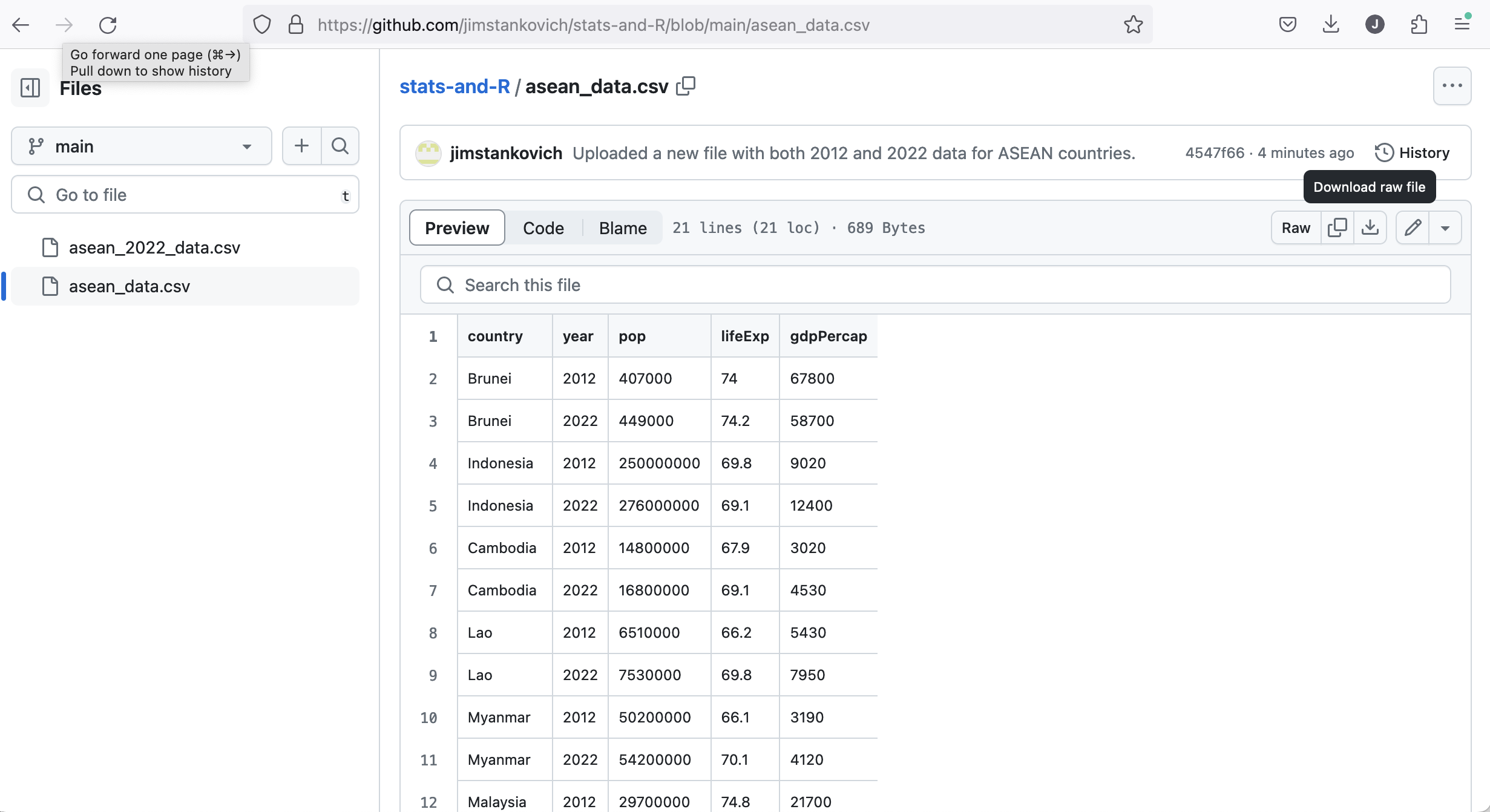
Click on this arrow to download the CSV file.
Find where the file was downloaded on your computer, and move it to a folder where you want to keep it.
In the “Files” window of RStudio (bottom right), navigate to the folder where you put the data, select the file, and choose “Import Dataset…” 
A new window appears, giving you some options to control how you open the file. In this case the default settings are fine… you don’t need to change anything. So just click “Import” on the bottom right to load the data. Note that the 3 R commands which will be run appear in a box on the bottom right. 
These 3 commands run in the Console window on the bottom left. The folder in the second line will be different on your computer (not the same as "~/Documents/Research Methodology in Social Sciences/introduction_to_R/data/"), depending on where you put the file asean_2022_data.csv.
Copy these 3 commands to your .R file so you can run them automatically next time, without having to open windows and click in them. This makes your analysis more “reproducible”.
Let’s look at the 3 commands and what they do:
library(readr): The library() function makes the package readr available for use (as mentioned in Section 2.12 above).
asean_data <- read_csv("[path_to_folder]/asean_data.csv"): The function read_csv is part of the readr package. Here it reads the CSV file asean_data.csv into R’s memory and gives it the name asean_data. (We could call it something else if we wanted to.) Some information appears in the Console window about the data. The country column has text information (character or “chr” for short). The other 4 columns (year, pop, lifeExp, gdpPercap) have numerical information (stored as “double-precision” numbers, or “dbl” for short… don’t worry about this computer science terminology if you haven’t heard it before).

View(asean_data): This command opens a spreadsheet-style view of the data on the top-left. If you close this window the data is stored in R… it is just a “view” of the data.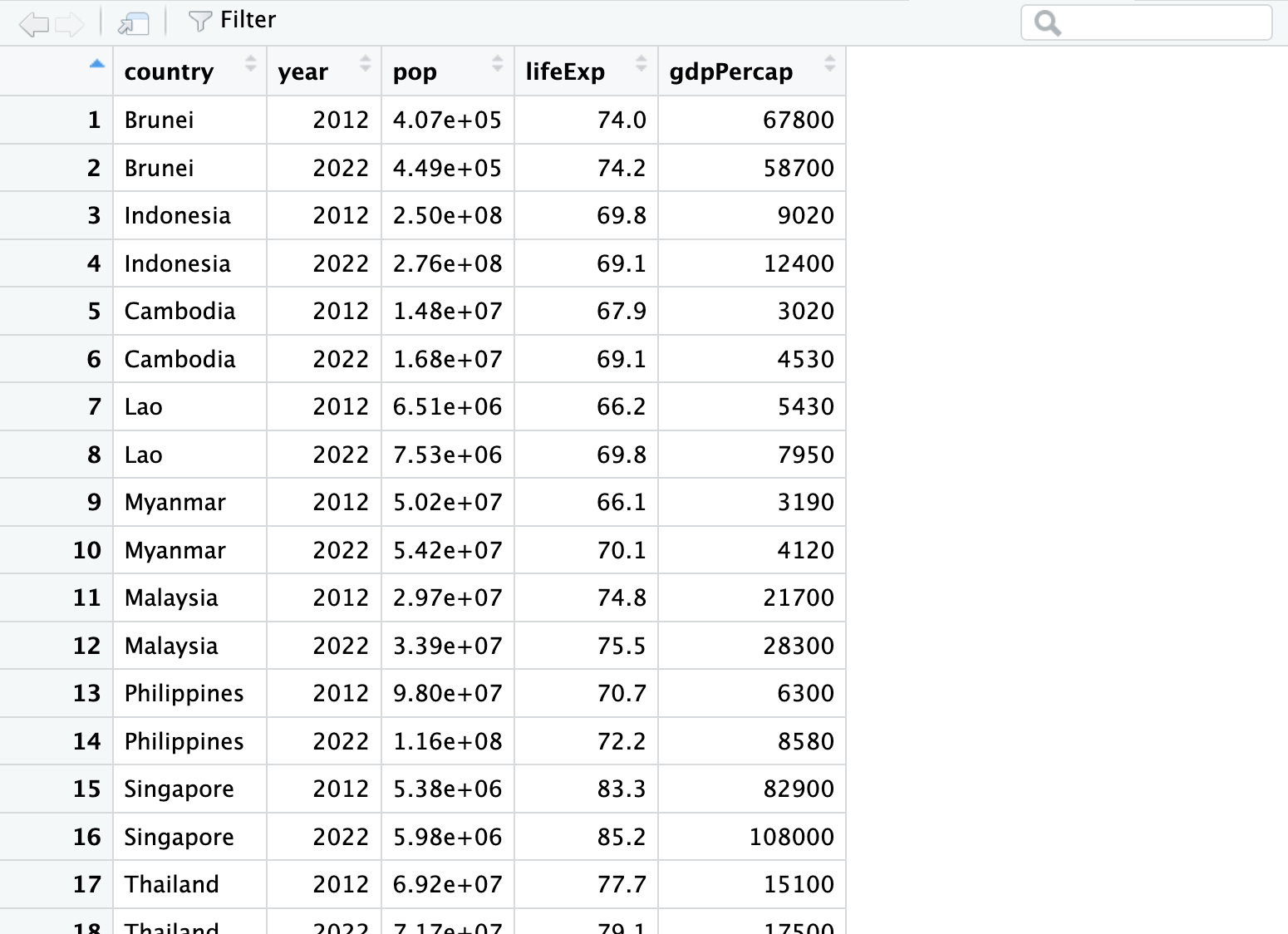
When you load the data, asean_data also appears in the “Environment” window on the top-right. If you click the little blue arrow, it provides some information on the variables in the data:

In summary, 3 of the 4 windows in RStudio are showing similar information about the data we have just loaded. :) It is up to you to decide which way(s) of looking at the data are most helpful.
Yet another way to look at the data is to type the name of the dataset in the Console window:
# A tibble: 20 × 5
country year pop lifeExp gdpPercap
<chr> <dbl> <dbl> <dbl> <dbl>
1 Brunei 2012 407000 74 67800
2 Brunei 2022 449000 74.2 58700
3 Indonesia 2012 250000000 69.8 9020
4 Indonesia 2022 276000000 69.1 12400
5 Cambodia 2012 14800000 67.9 3020
6 Cambodia 2022 16800000 69.1 4530
7 Lao 2012 6510000 66.2 5430
8 Lao 2022 7530000 69.8 7950
9 Myanmar 2012 50200000 66.1 3190
10 Myanmar 2022 54200000 70.1 4120
11 Malaysia 2012 29700000 74.8 21700
12 Malaysia 2022 33900000 75.5 28300
13 Philippines 2012 98000000 70.7 6300
14 Philippines 2022 116000000 72.2 8580
15 Singapore 2012 5380000 83.3 82900
16 Singapore 2022 5980000 85.2 108000
17 Thailand 2012 69200000 77.7 15100
18 Thailand 2022 71700000 79.1 17500
19 Vietnam 2012 89300000 73.5 6950
20 Vietnam 2022 98200000 75 11400If you have your own data in a CSV file, trying loading it using the read_csv() command. Then try adapting some of the commands below to apply them to your data.
Starting at the same URL as before (https://github.com/jimstankovich/notes/blob/main/data/asean_data.csv), click on the word “Raw” on the top right. This takes you take another webpage with the “raw” (unformatted) CSV data. You can use the read_csv command to load the data from this webpage:
Method 2 is fine for the small dataset we are looking at here. However, if you are running your R commands many times and working with a large dataset, it is better to download the dataset onto your computer first (Method 1), rather than downloading a large dataset many times.
dplyr package to look at the asean_dataI use the dplyr package more than any other packages. It is very useful for managing datasets: cleaning them, joining them, and selecting smaller sections for statistical analysis.
Let’s look at how a few dplyr functions can be applied to the asean_data.
Suppose we want to know the total population of the 10 ASEAN countries in 2022. We can do this by adding up the values of pop in the rows from 2022. Let’s do this in 2 steps:
pop.dplyr has a command called filter() for selecting particular rows of a dataset. The filter() command takes two arguments
# A tibble: 10 × 5
country year pop lifeExp gdpPercap
<chr> <dbl> <dbl> <dbl> <dbl>
1 Brunei 2022 449000 74.2 58700
2 Indonesia 2022 276000000 69.1 12400
3 Cambodia 2022 16800000 69.1 4530
4 Lao 2022 7530000 69.8 7950
5 Myanmar 2022 54200000 70.1 4120
6 Malaysia 2022 33900000 75.5 28300
7 Philippines 2022 116000000 72.2 8580
8 Singapore 2022 5980000 85.2 108000
9 Thailand 2022 71700000 79.1 17500
10 Vietnam 2022 98200000 75 11400Many dplyr functions take the name of a data.frame as the first argument. There is an alternative notation for running these functions, where you put the name of the data.frame before the function, then join it to the function using the symbol %>%
# A tibble: 10 × 5
country year pop lifeExp gdpPercap
<chr> <dbl> <dbl> <dbl> <dbl>
1 Brunei 2022 449000 74.2 58700
2 Indonesia 2022 276000000 69.1 12400
3 Cambodia 2022 16800000 69.1 4530
4 Lao 2022 7530000 69.8 7950
5 Myanmar 2022 54200000 70.1 4120
6 Malaysia 2022 33900000 75.5 28300
7 Philippines 2022 116000000 72.2 8580
8 Singapore 2022 5980000 85.2 108000
9 Thailand 2022 71700000 79.1 17500
10 Vietnam 2022 98200000 75 11400I think this notation makes it clearer that we are starting with the asean_data data.frame, then applying the filter() function to make changes to it and produce asean_2022.
The %>% notation is particularly good when you want to apply several functions to a data.frame. Below are two pieces of code that do the same thing… which do you think is easier to read?
Now we can use the sum() function to add up the values of pop in asean_2022:
So the total population of the ASEAN countries in 2022 was nearly 681 million. The function sum() is part of “base R”… you don’t need to load dplyr to use it.
Use the filter() function twice to select the row of asean_data containing 2012 statistics for the Philippines.
In 2012, what was the combined population of the 5 ASEAN countries that the Mekong River flows through?
mekong_countries_2012 <- asean_data %>%
filter(year == 2012) %>%
filter(country %in% countries_on_Mekong_River)
mekong_countries_2012# A tibble: 5 × 5
country year pop lifeExp gdpPercap
<chr> <dbl> <dbl> <dbl> <dbl>
1 Cambodia 2012 14800000 67.9 3020
2 Lao 2012 6510000 66.2 5430
3 Myanmar 2012 50200000 66.1 3190
4 Thailand 2012 69200000 77.7 15100
5 Vietnam 2012 89300000 73.5 6950[1] 230010000Suppose we want to calculate the average GDP (Gross Domestic Product) per person, averaged across all 681 million people living in ASEAN countries. The GDP figures in this dataset are in 2017 (inflation-adjusted) US dollars at purchasing power parity.
Here are the steps for calculating average GDP:
Total GDP for each country is equal to the country’s population multiplied by GDP per person (per capita). Let’s add a total_gdp column to the asean_2022 data.frame using a dplyr command called mutate():
# A tibble: 10 × 6
country year pop lifeExp gdpPercap gdp
<chr> <dbl> <dbl> <dbl> <dbl> <dbl>
1 Brunei 2022 449000 74.2 58700 26356300000
2 Indonesia 2022 276000000 69.1 12400 3422400000000
3 Cambodia 2022 16800000 69.1 4530 76104000000
4 Lao 2022 7530000 69.8 7950 59863500000
5 Myanmar 2022 54200000 70.1 4120 223304000000
6 Malaysia 2022 33900000 75.5 28300 959370000000
7 Philippines 2022 116000000 72.2 8580 995280000000
8 Singapore 2022 5980000 85.2 108000 645840000000
9 Thailand 2022 71700000 79.1 17500 1254750000000
10 Vietnam 2022 98200000 75 11400 1119480000000Then we can add up total_gdp across countries using the sum() function again:
and calculate
Here is some dplyr code that starts with our original CSV file (asean_data), and generates a summary of the 2022 population and GDP statistics for the whole of ASEAN.
asean_2022_summary <- asean_data %>%
filter(year == 2022) %>%
mutate(gdp = pop * gdpPercap) %>%
summarise(
pop = sum(pop),
total_gdp = sum(gdp),
gdpPercap = total_gdp / pop)
asean_2022_summary# A tibble: 1 × 3
pop total_gdp gdpPercap
<dbl> <dbl> <dbl>
1 680759000 8782747800000 12901.It uses filter() and mutate() in the same way we’ve seen before. There is also a new command summarise().
If we wanted these statistics for both 2012 and 2022, we could remove the filter() function, keep data for both year, and instead apply another function group_by() before summarise(), to generate summaries for both years at the same time.
asean_gdp_summary <- asean_data %>%
mutate(gdp = pop * gdpPercap) %>%
group_by(year) %>%
summarise(
pop = sum(pop),
total_gdp = sum(gdp),
gdpPercap = total_gdp / pop)
asean_gdp_summary# A tibble: 2 × 4
year pop total_gdp gdpPercap
<dbl> <dbl> <dbl> <dbl>
1 2012 613497000 5896224900000 9611.
2 2022 680759000 8782747800000 12901.I don’t think the total_gdp column is very useful… trillions of dollars seem to big to understand. We can select columns to keep using another dplyr command, select():
# A tibble: 2 × 3
year pop gdpPercap
<dbl> <dbl> <dbl>
1 2012 613497000 9611.
2 2022 680759000 12901.Or we can exclude particular columns by putting a - in front of their names:
dplyr functions we have usedfilter(): for selecting particular rows of a data.framemutate(): for adding a new column (vector) to a data.frame, or to change an existing columnsummarise(): to calculate things like sums or averages across multiple rowsgroup_by(): I don’t properly understand all the ways this function is used, but I often use it before summarise(), to calculate summaries by groups (e.g. for different years in the example above)There is a useful summary of dplyr commands on this Data Wrangling Cheat Sheet.
ggplot2 packageI haven’t used ggplot2 much: I usually plot graphs using “base R” (without using any packages). However, many people recommend ggplot2 for graphs, so I am trying it out. I don’t yet understand the “grammar of graphics” used in ggplot2, so I’m definitely not qualified to teach anyone how to use it! Nevertheless, I’m still including this section to
ggplot2 commands look, andI did a lot of googling to make the graphs below. I have included links to some pages that helped.
I was impressed how fast it was to make some fairly complicated graphs with ggplot2, so I think I’ll start using it more to explore data. I really like base R for fine-tuning graphs and converting them to pdf files for publications, so I may keep using base R for that.
library(ggplot2)
#https://r-graph-gallery.com/218-basic-barplots-with-ggplot2.html
#http://www.sthda.com/english/wiki/ggplot2-title-main-axis-and-legend-titles
#https://stackoverflow.com/questions/15629192/making-a-bar-chart-in-ggplot-with-vertical-labels-in-x-axis
#https://www.r-bloggers.com/2021/09/adding-text-labels-to-ggplot2-bar-chart/
ggplot(asean_2022, aes(x=country, y=lifeExp)) +
geom_bar(fill = "dodgerblue3", stat = "identity") +
ylab("Life expectancy at birth (2022)") +
geom_text(aes(label = lifeExp, vjust = 1.2)) +
theme_light() +
theme(axis.text.x=element_text(angle=90,hjust=1,vjust=0.5))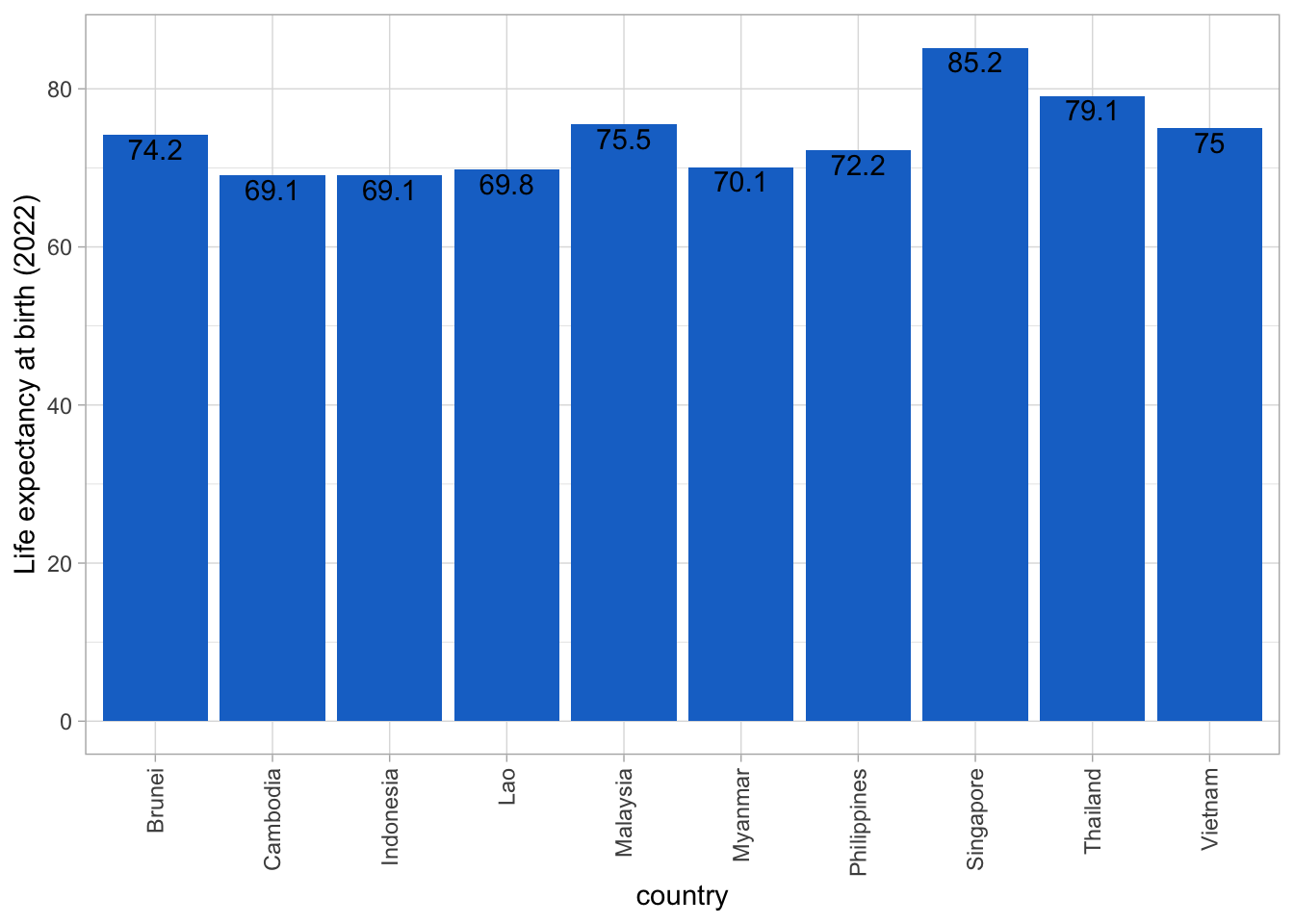
#https://rpubs.com/dvdunne/ggplot_two_bars
ggplot(asean_data, aes(x=country, y=lifeExp, fill=year)) +
geom_bar(stat = "identity", position = "dodge") +
ylab("Life expectancy at birth") +
theme_light() +
theme(axis.text.x=element_text(angle=90,hjust=1,vjust=0.5))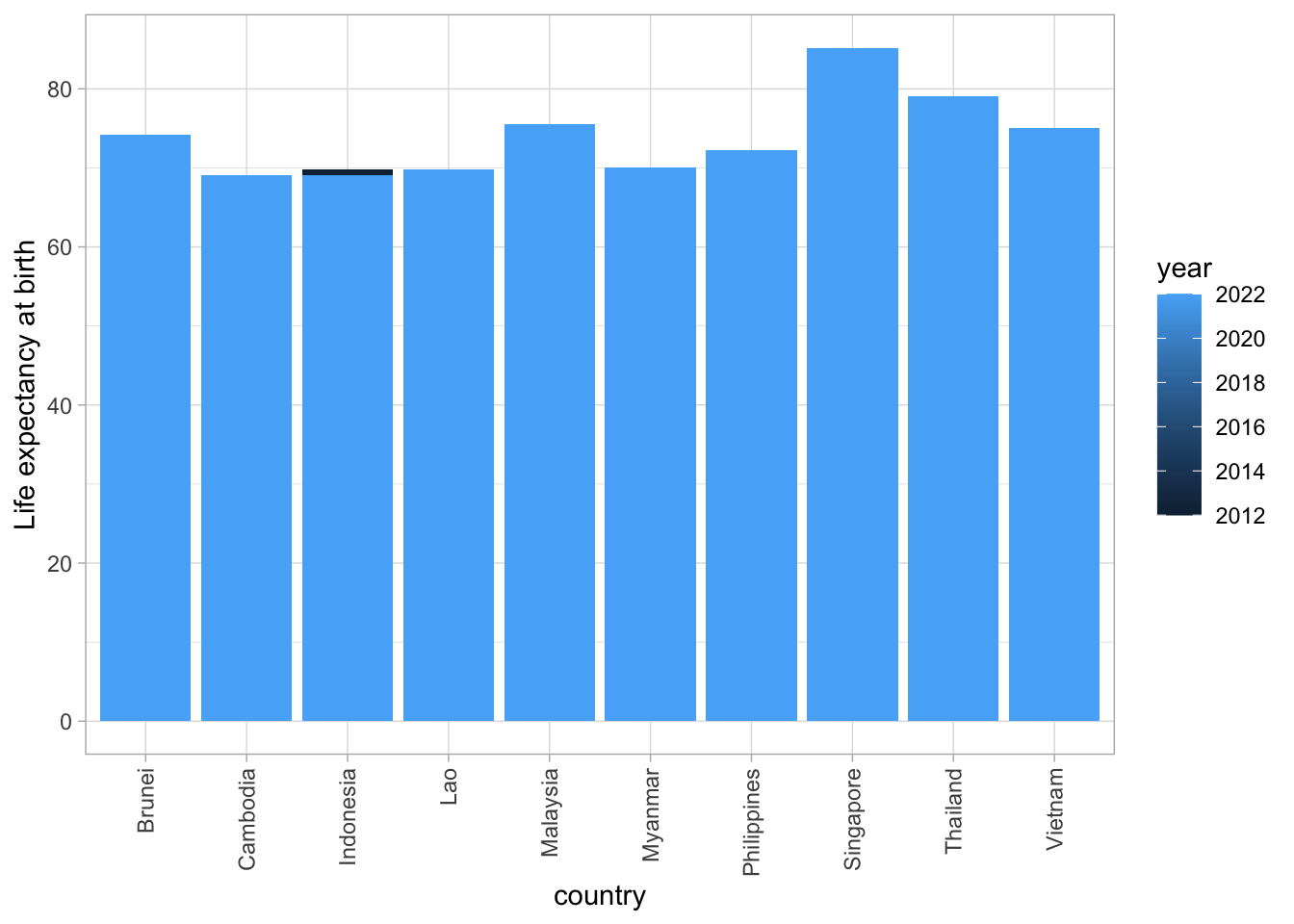
This is not what we want! Year is being treated as a continuous variable, ranging in value from 2012 to 2022. We can fix this by converting year to a categorical variable (called a factor in R).
asean_data <- asean_data %>%
mutate(year = as.factor(year))
ggplot(asean_data, aes(x=country, y=lifeExp, fill=year)) +
geom_bar(stat = "identity", position = "dodge") +
ylab("Life expectancy at birth") +
theme_light() +
theme(axis.text.x=element_text(angle=90,hjust=1,vjust=0.5))
Let’s calculate change in life expectancy between 2012 and 2022 for each country. To do this, let’s make a table that has one row for each country, and separate columns for life expectancy in 2012 (le2012) and 2022 (le2022). We can do this by using group_by() and summarise() again.
life_exp_table <- asean_data %>%
arrange(year) %>%
group_by(country) %>%
summarise(
le2012 = first(lifeExp),
le2022 = last(lifeExp),
le_change = le2022 - le2012,
pop2022 = last(pop))
life_exp_table# A tibble: 10 × 5
country le2012 le2022 le_change pop2022
<chr> <dbl> <dbl> <dbl> <dbl>
1 Brunei 74 74.2 0.200 449000
2 Cambodia 67.9 69.1 1.20 16800000
3 Indonesia 69.8 69.1 -0.700 276000000
4 Lao 66.2 69.8 3.60 7530000
5 Malaysia 74.8 75.5 0.700 33900000
6 Myanmar 66.1 70.1 4 54200000
7 Philippines 70.7 72.2 1.5 116000000
8 Singapore 83.3 85.2 1.90 5980000
9 Thailand 77.7 79.1 1.40 71700000
10 Vietnam 73.5 75 1.5 98200000There are some other dplyr function in here that we haven’t seen before:
arrange(year) sorts the table by year, so that the 2012 data appears before the 2022 data
Once the data is grouped by country, the function first() is used to select the first life expectancy value for the country (the one for 2012), and the function last() is used to select the last life expectancy and population for the country (from 2022)
We can make a bar-graph to show the changes in life expectancy for each country:
library(ggplot2)
ggplot(life_exp_table, aes(x=country, y=le_change)) +
geom_bar(fill = "dodgerblue3", stat = "identity") +
ylab("change in life expectancy (years), 2012 -> 2022") +
geom_text(aes(label = round(le_change,1), vjust = -1)) +
theme_light() +
theme(axis.text.x=element_text(angle=90,hjust=1,vjust=0.5)) +
#https://ggplot2.tidyverse.org/reference/lims.html
ylim(-1, 4.5)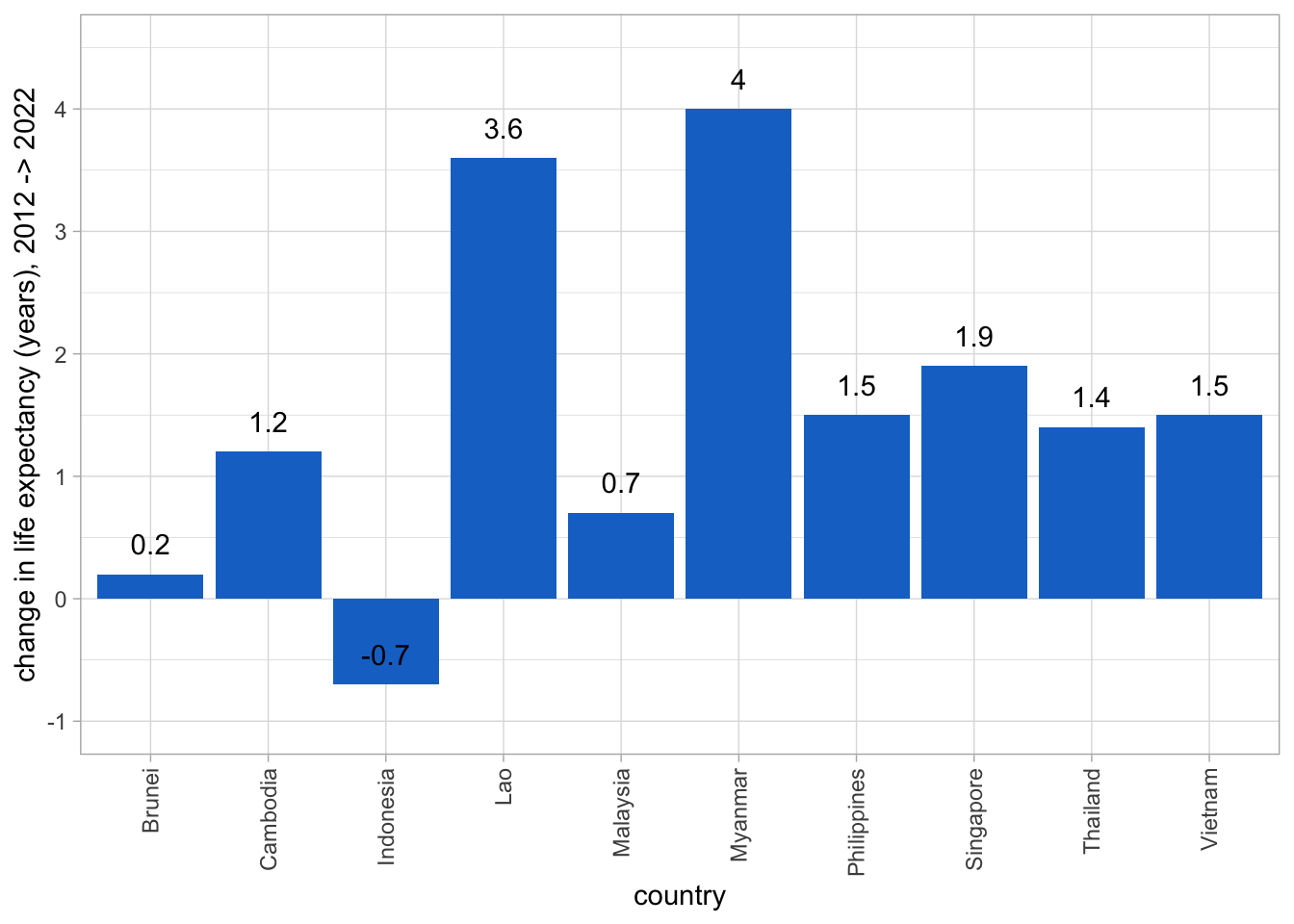
We can also do a paired t-test, to test the hypothesis that average life expectancy has increased from 2012 to 2022 across the 10 ASEAN countries. Here are 3 methods to do this test: they all give the same result.
t.test() function
Paired t-test
data: life_exp_table$le2022 and life_exp_table$le2012
t = 3.4135, df = 9, p-value = 0.007707
alternative hypothesis: true mean difference is not equal to 0
95 percent confidence interval:
0.5160589 2.5439411
sample estimates:
mean difference
1.53 lm() function
Call:
lm(formula = le_change ~ 1, data = life_exp_table)
Residuals:
Min 1Q Median 3Q Max
-2.230 -0.705 -0.080 0.270 2.470
Coefficients:
Estimate Std. Error t value Pr(>|t|)
(Intercept) 1.5300 0.4482 3.414 0.00771 **
---
Signif. codes: 0 '***' 0.001 '**' 0.01 '*' 0.05 '.' 0.1 ' ' 1
Residual standard error: 1.417 on 9 degrees of freedomlm() is the R function to linear regression. The paired t-test is equivalent to a simple linear regression model, with only a constant term in the model.
The paired t-test above treats all 10 countries equally. In some contexts, it might be more appropriate to give greater weight to the countries with larger populations:
weighted_regression_model <- lm(le_change ~ 1, weights = pop2022,
data = life_exp_table)
summary(weighted_regression_model)
Call:
lm(formula = le_change ~ 1, data = life_exp_table, weights = pop2022)
Weighted Residuals:
Min 1Q Median 3Q Max
-24508.0 146.2 4020.5 7609.2 23741.1
Coefficients:
Estimate Std. Error t value Pr(>|t|)
(Intercept) 0.7752 0.4739 1.636 0.136
Residual standard error: 12360 on 9 degrees of freedomTo plot the graphs from now on, you need to download a much bigger CSV file of Gapminder data, called big_gapminder_dataset.csv. It is available here.
# Change the folder below to point to the data you downloaded.
big_gapminder_dataset <- read_csv("~/Documents/Research Methodology in Social Sciences/introduction_to_R/data/big_gapminder_dataset.csv",
show_col_types = FALSE)
lifeExp_since_1900 <- big_gapminder_dataset %>%
filter(year >= 1900 & year <= 2022) %>%
select(country, continent, year, lifeExp) %>%
mutate(asean = country %in% ASEAN_countries)
asean_lifexp_since_1900 <- lifeExp_since_1900 %>%
filter(asean == TRUE)
other_countries <- lifeExp_since_1900 %>%
filter(asean == FALSE)
# This palette was recommended for people who are colour-blind
# https://stackoverflow.com/questions/9563711/r-color-palettes-for-many-data-classes
colours1 <- c("#88CCEE", "#CC6677", "#DDCC77", "#117733",
"#332288", "#AA4499", "#44AA99", "#999933",
"#882255", "#661100")
# Another palette from the start of the same chat
colours2 <- c(
"dodgerblue2", "#E31A1C", # red
"green4",
"#6A3D9A", # purple
"#FF7F00", # orange
"black", "gold1",
"skyblue2", "#FB9A99", # lt pink
"palegreen2")
# I found it easier to distinguish the countries using this palette
ggplot(data = asean_lifexp_since_1900, mapping = aes(x=year, y=lifeExp, group=country, color=country)) +
geom_line() +
scale_color_manual(values = colours2) +
ylab("Life expectancy at birth")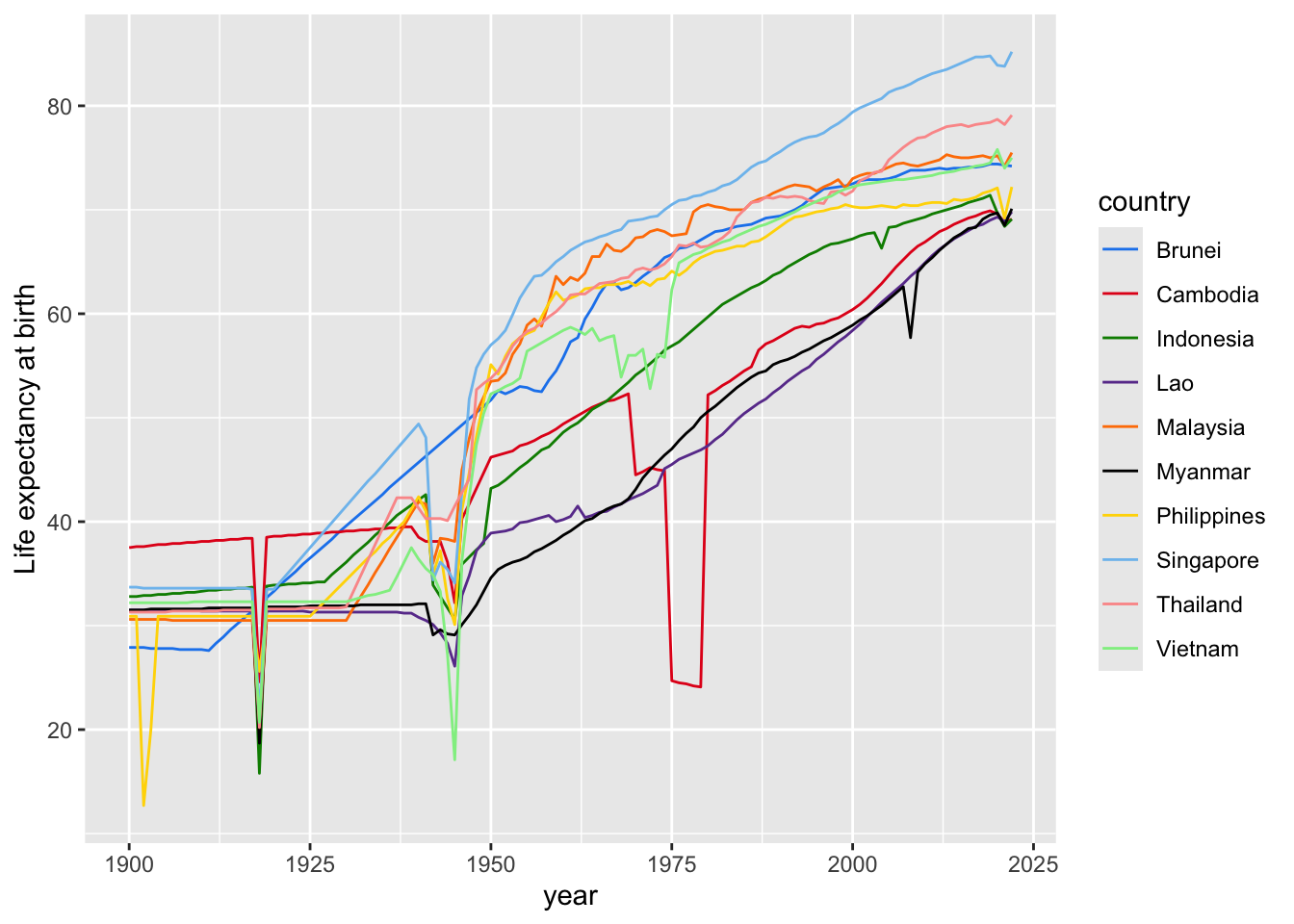
# https://stackoverflow.com/questions/40297206/overlaying-two-plots-using-ggplot2-in-r
ggplot(data = other_countries,
mapping = aes(x=year, y=lifeExp, group=country)) +
geom_line(col = rgb(0.8,0.8,0.8,0.5)) +
geom_line(data = asean_lifexp_since_1900,
mapping = aes(x=year, y=lifeExp, group=country,
color=country)) +
scale_color_manual(values = colours2) +
ylab("Life expectancy at birth")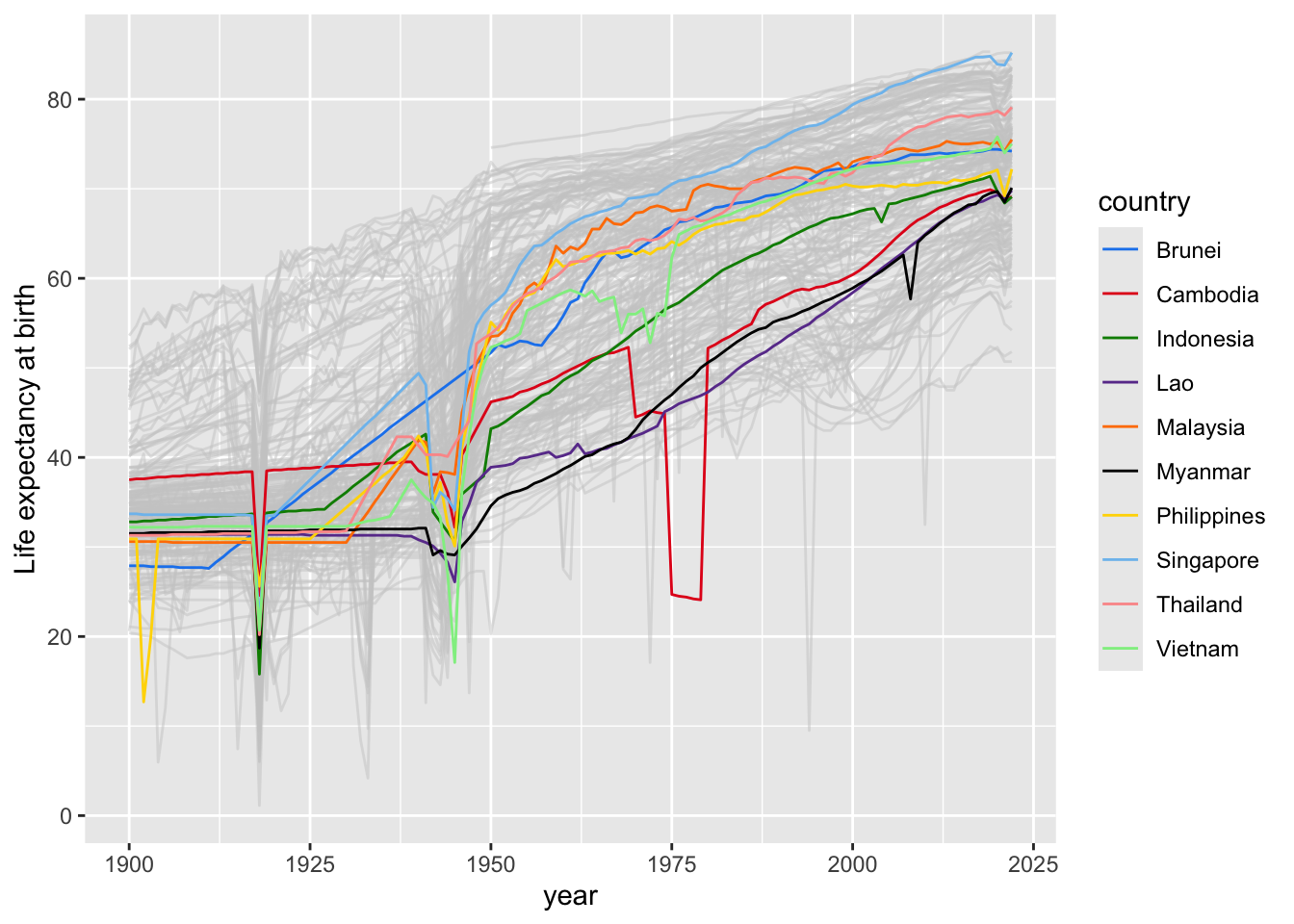
(Scatterplots with different-sized circles for different points)
asean_2022 %>%
ggplot(aes(x=gdpPercap, y=lifeExp, size=pop)) +
geom_point(col = "dodgerblue", alpha=0.5) +
scale_size(range = c(2, 24), name="Population") +
scale_x_log10(limits = c(2500, 170000)) +
ylim(65,87) +
xlab("GDP per capita, 2022 (purchasing power parity, 2017 US dollars)") +
ylab("life expectancy at birth, 2022") +
geom_text(aes(x=gdpPercap, y=lifeExp, label = country, size = 5*10^6, vjust = -1)) +
theme_light() +
#https://www.datanovia.com/en/blog/how-to-remove-legend-from-a-ggplot/
theme(legend.position = "none")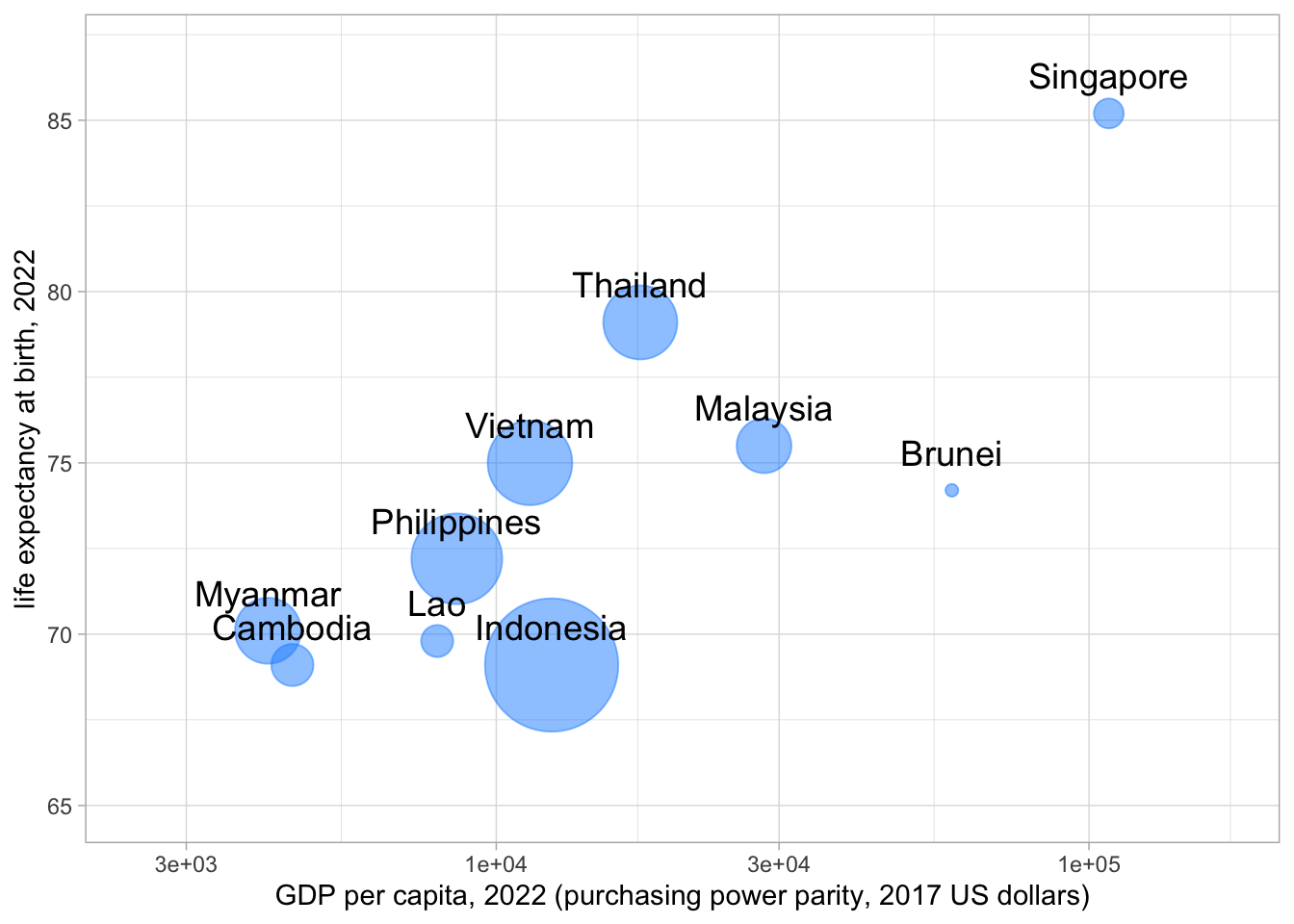
Make a rough match of the plot at https://www.gapminder.org/tools/:
world_2022 <- big_gapminder_dataset %>%
filter(year == "2022") %>%
filter(country != "Monaco") %>%
arrange(desc(pop))
# Monaco has a very high GDP per capita, and it doesn't appear in the plot
# at https://www.gapminder.org/tools/.
# So remove the data for Monaco with the != (not equal to) operator.
# arrange(desc(pop)) arranges the countries in order from largest population
# to smallest population. This means that the circles get plotted in order
# from largest to smallest, so the larger circles don't hide smaller circles.
world_2022 %>%
ggplot(aes(x=gdpPercap, y=lifeExp, size=pop, col=continent)) +
geom_point(alpha=0.5) +
scale_size(range = c(.1, 24), name="Population") +
scale_x_continuous(trans='log10') +
guides(size = "none") +
theme_light() +
xlab("GDP per capita, 2022 (purchasing power parity, 2017 US dollars)") +
ylab("life expectancy at birth, 2022")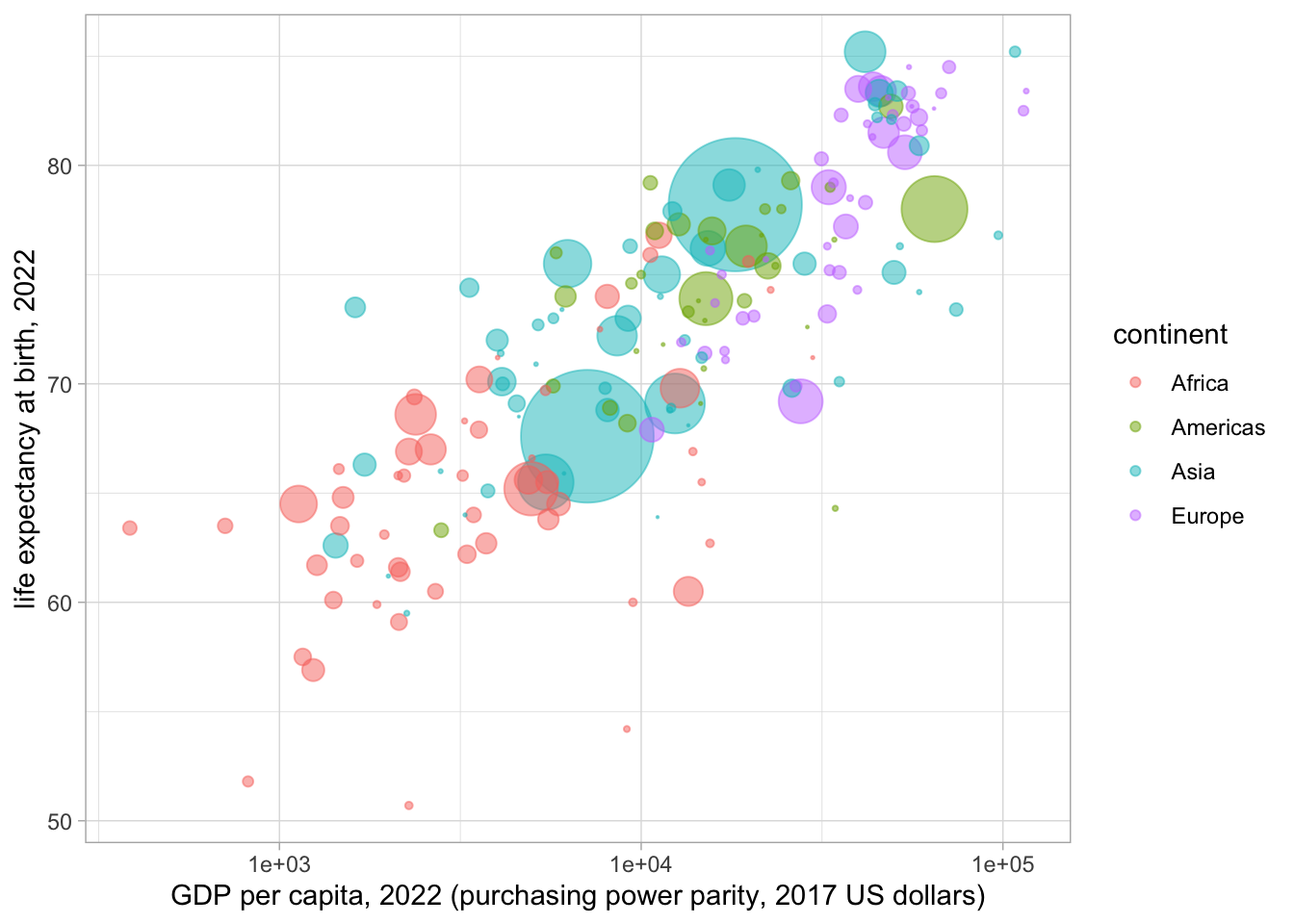
There are a lot of circles here, and we can’t tell which plot is which. It would be nice to reproduce the feature of the plot at the website above, which shows the name of each country each circle represents when you “hover” the mouse over it. It is possible to do this with another R package called plotly. You’ll need to install it before running the code below.
library(plotly)
continent_colours <- data.frame(
continent = c("Africa", "Americas", "Asia", "Europe"),
colour = c("rgba(95,210,230,1)", "rgba(154,231,71,1)",
"rgba(237,100,117,1)", "rgba(251,230,77,1)")
)
# This command makes a small data.frame assigning colours to continents.
# Plotly doesn't handle rows with missing data in the same way as ggplot2,
# so include a command to remove rows with missing data.
# is.na() tests whether the thing in brackets is missing.
# ! means "not". So !is.na() tests whether something is not missing.
# & means "and". So the command
# filter(!is.na(lifeExp) & !is.na(gdpPercap) & !is.na(pop))
# means: just keep the rows where
# lifeExp is not missing, AND
# gdpPercap is not missing, AND
# pop is not missing.
world_2022v2 <- world_2022 %>%
filter(!is.na(lifeExp) & !is.na(gdpPercap) & !is.na(pop)) %>%
left_join(continent_colours, by = "continent")
# left_join() is another dplyr function. It adds information from
# the small continent_colours table we just made to the world_2022
# table. The two tables are matched using values of "continent".
# This adds a column of colours to the world_2022 table, used for
# plotting below. So the dplyr cheatsheet mentioned above
# (https://www.rstudio.com/wp-content/uploads/2015/02/data-wrangling-cheatsheet.pdf)
# for a nice illustration of how left_join() works.
fig <- plot_ly(world_2022v2, x = ~gdpPercap, y = ~lifeExp, text = ~country,
type = "scatter", mode = "markers",
marker = list(size = ~(sqrt((pop)/300000)+0.2),
opacity = 0.8, color = ~colour))
# https://plotly.com/r/bubble-charts/
fig <- fig %>%
layout(fig,
title = "2022 Gapminder data",
xaxis = list(
type = "log",
title = "GDP per capita (purchasing power parity, 2017 US dollars)"),
yaxis = list(title = "life expectancy at birth"))
# https://plotly.com/r/figure-labels/
figTo work through this section, you need to run the first two R commands in Section 3.3.2 to create the data frames big_gapminder_dataset and lifeExp_since_1900.
In this talk given in 2006, Hans Rosling argues that undergraduate students in Sweden had “preconceived ideas” about global health. They mistakenly thought that there were very big differences in life expectancy between the “Western world” and rest of the world. Rosling shows that, while there was some truth to this in the 1960s, it was no longer the case in the 2006 (and is no longer the case now).
Let’s look at this with the Gapminder dataset: use unpaired t-tests to compare life expectancy in 1962 and 2022 between the ASEAN countries and the 10 biggest European countries (countries with population greater than 18 million in 2022).
Find the 10 biggest European countries with population greater than 18 million in 2022. To do this, we need the big_gapminder_dataset loaded in Section
europe_big <- big_gapminder_dataset %>%
filter(year == 2022) %>%
filter(continent == "Europe") %>%
filter(pop > 18000000) %>%
select(country, pop)
europe_big %>%
arrange(desc(pop))# A tibble: 10 × 2
country pop
<chr> <dbl>
1 Russia 145000000
2 Turkey 85300000
3 Germany 83400000
4 UK 67500000
5 France 64600000
6 Italy 59000000
7 Spain 47600000
8 Poland 39900000
9 Ukraine 39700000
10 Romania 19700000Make a dataset that just includes these countries and the ASEAN countries, and only includes data for 1962 and 2022. Create a column group that is “ASEAN” for the ASEAN countries and “Europe” for the European countries
asean_and_europe <- lifeExp_since_1900 %>%
filter(asean == T | country %in% europe_big$country) %>%
mutate(group = ifelse(asean==T, "ASEAN", "Europe")) %>%
filter(year %in% c(1962, 2022))
asean_and_europe# A tibble: 40 × 6
country continent year lifeExp asean group
<chr> <chr> <dbl> <dbl> <lgl> <chr>
1 Brunei Asia 1962 57.7 TRUE ASEAN
2 Brunei Asia 2022 74.2 TRUE ASEAN
3 Germany Europe 1962 70 FALSE Europe
4 Germany Europe 2022 80.6 FALSE Europe
5 Spain Europe 1962 69.8 FALSE Europe
6 Spain Europe 2022 83.5 FALSE Europe
7 France Europe 1962 71.2 FALSE Europe
8 France Europe 2022 83.4 FALSE Europe
9 UK Europe 1962 71 FALSE Europe
10 UK Europe 2022 81.5 FALSE Europe
# ℹ 30 more rowsMake a dataset just with the 1962 data, and arrange the countries in order of life expectancy.
# A tibble: 20 × 6
country continent year lifeExp asean group
<chr> <chr> <dbl> <dbl> <lgl> <chr>
1 Myanmar Asia 1962 39.6 TRUE ASEAN
2 Lao Asia 1962 41.5 TRUE ASEAN
3 Indonesia Asia 1962 49.5 TRUE ASEAN
4 Cambodia Asia 1962 50.2 TRUE ASEAN
5 Turkey Europe 1962 51 FALSE Europe
6 Brunei Asia 1962 57.7 TRUE ASEAN
7 Vietnam Asia 1962 58.4 TRUE ASEAN
8 Philippines Asia 1962 61.8 TRUE ASEAN
9 Thailand Asia 1962 61.9 TRUE ASEAN
10 Malaysia Asia 1962 63.2 TRUE ASEAN
11 Singapore Asia 1962 66.5 TRUE ASEAN
12 Romania Europe 1962 66.7 FALSE Europe
13 Poland Europe 1962 67.9 FALSE Europe
14 Russia Europe 1962 69.1 FALSE Europe
15 Spain Europe 1962 69.8 FALSE Europe
16 Italy Europe 1962 69.9 FALSE Europe
17 Germany Europe 1962 70 FALSE Europe
18 UK Europe 1962 71 FALSE Europe
19 Ukraine Europe 1962 71 FALSE Europe
20 France Europe 1962 71.2 FALSE EuropeMake a scatterplot of the 1962 life expectancy data, using the x-axis to separate the ASEAN countries and European countries:
Add some country names:
# Make a vector of distances to shift the country names left and right
# (so they don't appear on top of the blue dots).
shift_text <- rep(c(-0.25,0.25), 10)
shift_text [1] -0.25 0.25 -0.25 0.25 -0.25 0.25 -0.25 0.25 -0.25 0.25 -0.25 0.25
[13] -0.25 0.25 -0.25 0.25 -0.25 0.25 -0.25 0.25# Add the text to the plot we made in Step 4 above.
# I found instructions on how to shift the text at
# https://ggplot2.tidyverse.org/reference/position_nudge.html
plot_1962 +
geom_text(aes(label = country),
position = position_nudge(x = shift_text))
Use an unpaired t-test to test the hypothesis that life expectancy in 1962 was higher in the European countries than the ASEAN countries:
Welch Two Sample t-test
data: lifeExp by group
t = -3.6162, df = 15.437, p-value = 0.002438
alternative hypothesis: true difference in means between group ASEAN and group Europe is not equal to 0
95 percent confidence interval:
-20.214816 -5.245184
sample estimates:
mean in group ASEAN mean in group Europe
55.03 67.76 lifeExp_2022 <- asean_and_europe %>%
filter(year == 2022) %>%
arrange(lifeExp)
lifeExp_2022 %>%
ggplot(aes(x=group, y=lifeExp)) +
geom_point(col = "dodgerblue", size = 2) +
geom_text(aes(label = country),
position = position_nudge(x = shift_text))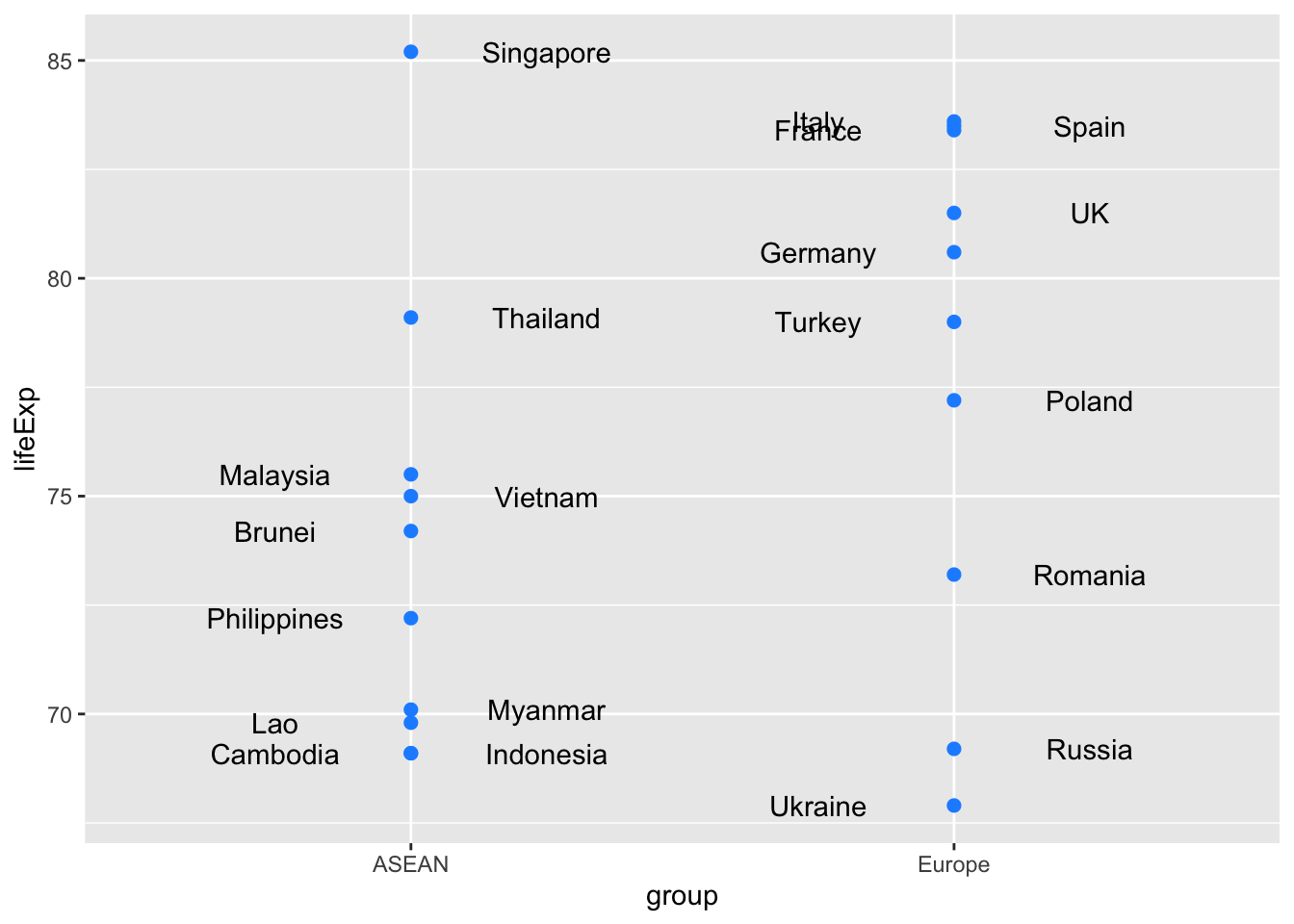
Welch Two Sample t-test
data: lifeExp by group
t = -1.6062, df = 17.674, p-value = 0.126
alternative hypothesis: true difference in means between group ASEAN and group Europe is not equal to 0
95 percent confidence interval:
-9.192908 1.232908
sample estimates:
mean in group ASEAN mean in group Europe
73.93 77.91 Here are commands to make a two-by-two table showing numbers of countries in Asia and Europe with life expectancies above and below 60 in 1962.
life_exp_1962 <- lifeExp_since_1900 %>%
filter(year == 1962) %>%
filter(continent %in% c("Asia", "Europe")) %>%
mutate(lifeExpCat = ifelse(lifeExp < 60, "le < 60", "le >= 60"))
tab_1962 <- table(life_exp_1962$lifeExpCat, life_exp_1962$continent)
tab_1962
Asia Europe
le < 60 34 5
le >= 60 25 43Once we have created the table, we can use the chi.sq() command to run a chi-square test:
Pearson's Chi-squared test with Yates' continuity correction
data: tab_1962
X-squared = 23.47, df = 1, p-value = 1.269e-06The small p-value indicates that, in 1962, there was a significant difference between
Modify the code above to make a table showing numbers of Asian and European countries with life expectancy above and below 75. Then run a chi-square test to assess the signficance of the difference in proportions.
life_exp_2022 <- lifeExp_since_1900 %>%
filter(year == 2022) %>%
filter(continent %in% c("Asia", "Europe")) %>%
mutate(lifeExpCat = ifelse(lifeExp < 75, "le < 75", "le >= 75"))
tab_2022 <- table(life_exp_2022$lifeExpCat, life_exp_2022$continent)
tab_2022
Asia Europe
le < 75 38 12
le >= 75 20 35
Pearson's Chi-squared test with Yates' continuity correction
data: tab_2022
X-squared = 15.077, df = 1, p-value = 0.0001032Apart from the sources mentioned in Section 1.1, another excellent place to learn more about R is the free online book R for Data Science (2nd edition), by Hadley Wickham, Mine Çetinkaya-Rundel and Garrett Grolemund.